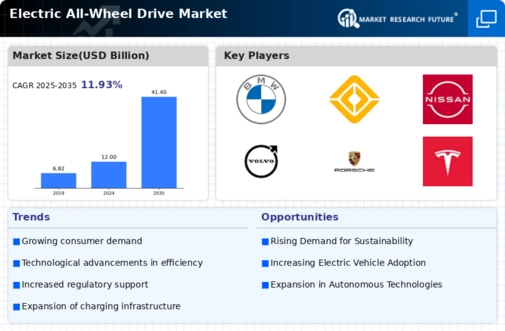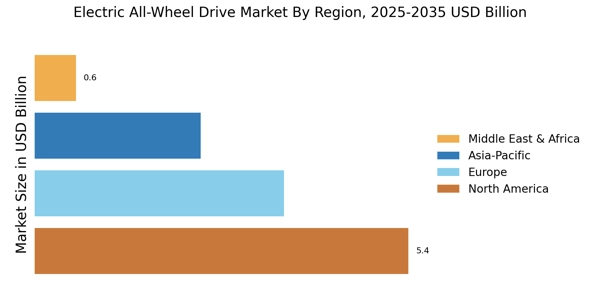Rising Fuel Prices
The Electric All-Wheel Drive Market is also being propelled by the rising prices of fossil fuels. As consumers face increasing fuel costs, many are turning to electric vehicles as a cost-effective alternative. Electric vehicles, particularly those with all-wheel drive capabilities, offer the advantage of lower operating costs compared to traditional vehicles. Data indicates that the total cost of ownership for electric vehicles is becoming increasingly favorable, making them an attractive option for budget-conscious consumers. This trend suggests that the Electric All-Wheel Drive Market may continue to grow as more individuals seek to mitigate the financial impact of fluctuating fuel prices.
Government Incentives and Policies
The Electric All-Wheel Drive Market is significantly influenced by government incentives and policies aimed at promoting electric mobility. Various countries have implemented tax credits, rebates, and grants to encourage consumers to purchase electric vehicles. These initiatives not only lower the upfront costs for consumers but also stimulate market growth. For instance, data shows that regions with robust government support for electric vehicles have experienced a marked increase in sales, contributing to the expansion of the Electric All-Wheel Drive Market. As governments continue to prioritize clean energy and transportation solutions, the market is likely to see further growth driven by favorable policies.
Increasing Environmental Awareness
The Electric All-Wheel Drive Market is benefiting from a growing awareness of environmental issues among consumers. As climate change concerns escalate, individuals are increasingly seeking sustainable transportation options. Electric vehicles, particularly those equipped with all-wheel drive systems, are perceived as a cleaner alternative to traditional combustion engine vehicles. This shift in consumer behavior is supported by data indicating that electric vehicle sales have seen a substantial increase, with many consumers prioritizing eco-friendly features. The Electric All-Wheel Drive Market is thus positioned to capitalize on this trend, as manufacturers respond to consumer demand by developing more environmentally friendly vehicles that align with sustainability goals.
Enhanced Vehicle Performance and Safety Features
The Electric All-Wheel Drive Market is witnessing a focus on enhanced vehicle performance and safety features, which are becoming critical selling points for consumers. All-wheel drive systems in electric vehicles provide improved traction and stability, particularly in adverse weather conditions. Additionally, advancements in safety technologies, such as collision avoidance systems and adaptive cruise control, are being integrated into electric all-wheel drive vehicles. This emphasis on performance and safety is supported by market data indicating that consumers are increasingly prioritizing these attributes when selecting vehicles. As manufacturers continue to innovate, the Electric All-Wheel Drive Market is likely to see sustained interest from consumers seeking high-performance, safe, and reliable electric vehicles.
Technological Innovations in Electric All-Wheel Drive Systems
The Electric All-Wheel Drive Market is experiencing a surge in technological innovations that enhance vehicle performance and efficiency. Advanced battery technologies, such as solid-state batteries, are being developed, which could potentially increase the range and reduce charging times for electric vehicles. Furthermore, the integration of artificial intelligence in all-wheel drive systems allows for real-time adjustments to power distribution, improving traction and stability. According to recent data, the market for electric vehicles is projected to grow at a compound annual growth rate of over 20% in the coming years, driven by these technological advancements. As manufacturers invest in research and development, the Electric All-Wheel Drive Market is likely to witness a transformation that could redefine consumer expectations and vehicle capabilities.


















Leave a Comment